 Ice cream is a staple dessert in the Western diet. Its creaminess and coolness makes it ideal as a go-to summer treat.
Ice cream is a staple dessert in the Western diet. Its creaminess and coolness makes it ideal as a go-to summer treat.
The variety of flavors allows ice cream to be an indulgence to almost any sweet-lover, but have you ever wondered what makes it taste so phenomenal?
What is in ice cream that makes it so desirable?
Can the ingredients in ice cream be damaging to the body, and if yes, how so?
Sadly, this favorite snack can wreak major havoc on the digestive tract. Just like in most junk food, it is the additives, emulsifiers and preservatives that do the most significant damage to the body.
While the cream and sugar themselves are not the best ingredients to eat, the human body has digestive enzymes and bacteria that are able to digest these ingredients — our bodies do not contain digestive enzymes or bacteria that are intended to digest these added ingredients.
Emulsifiers
An emulsifier is something that is typically used to prevent oils and fats from separating. This includes polysorbate 80, lecithin, carrageenan, polyglycerols and cellulose gum.
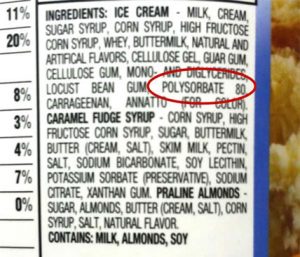
They extend the shelf-life of ingredients and are cheaper for manufacturers to use instead of whole food ingredients.
According to a study released in Nature, these ingredients interfere with the body’s gut microbiome and may lead to obesity, metabolic syndrome and inflammatory bowel disease.
Another study found that emulsifiers not only alter the microbiota composition in the human body, but that this alteration leads to low-grade inflammation which can play a major role in colorectal cancer and promote the growth of tumors (so if you have or know someone with cancer in their digestive tract, be sure to stay away from emulsifiers!).
Artificial Colors
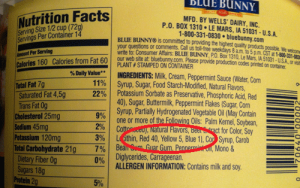 Red #40, Red #3, Yellow #5 and Blue #1 are all familiar artificial colors.
Red #40, Red #3, Yellow #5 and Blue #1 are all familiar artificial colors.
The International Association of Color Manufacturers states that artificial food dyes are used for the enhancement and correction of natural colors—so they’re basically used to make food look prettier than it does in a natural state.
These colors have proven links to hyperactivity in children and are also connected to allergies and cancer.
The colors Red #40, Yellow #5 and Yellow #6 contain an ingredient called benzidene which is a known human carcinogen.
The FDA states that it falls within the “safe” levels, but the problem is that the FDA tests only measure for free benzidene.
In these colors, benzidene is found in both a free and bound form.
Essentially, those ingesting these food dyes will be ingesting far more benzidene than is recognized by the FDA simply because their testing methods do not measure the full quantity.
It is no secret that artificial colors should be intentionally avoided so be sure to look for them in the ingredient list as they are part of many brands of ice creams.
Artificial Flavors
Artificial flavors cover a variety of ingredients that are not derived from natural sources.
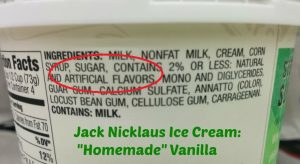
The FDA defines these as “any substance, the function of which is to impart flavor, which is not derived from a spice, fruit or fruit juice, vegetable or vegetable juice, edible yeast, herb, bark, bud, root, leaf or similar plant material, meat, fish, poultry, eggs, dairy products, or fermentation products thereof.”
Essentially, chemicals are used to impart a particular flavor into fake food. Each “artificial flavor” may contain up to 100 ingredients by itself, including BHA, propylene glycol, MSG and many others.
Partially Hydrogenated Oils
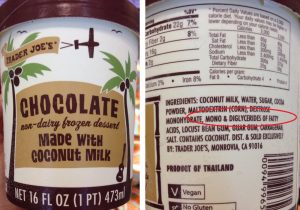 These oils are the major source of trans fat in the American diet. While the FDA has called for all foods to have trans fats removed over the next few years, many still contain some level of trans fats in the form of mono- and diglycerides.
These oils are the major source of trans fat in the American diet. While the FDA has called for all foods to have trans fats removed over the next few years, many still contain some level of trans fats in the form of mono- and diglycerides.
What makes it challenging to stay away from mono- and diglycerides is the fact that companies are only required to label triglycerides as “trans fats” so foods that say, “No Trans Fat” may actually still contain them!
There is no safe level of these ingredients for the human body so it is important that we do not consume partially hydrogenated oils. These oils are often found in “diet” versions of ice cream, so be aware that these versions are not necessarily healthier.
According to studies, these fats interfere with the body’s bacterial communities which can lead to a variety of health issues that not only affect the digestive tract, but may also lead to immune and metabolic disorders.
Sugar Substitutes
Because sugar is known to have detrimental effects on the body, especially in the large amounts consumed in the American diet, many people look to sugar alcohols and other non-nutritive sweeteners for the sweet taste they crave.
It seems like a better alternative initially, but when you study the impact that these sugar alternatives can have on the body, you realize they are not actually better than real sugar.
Many artificial sweeteners are derived from GMO corn and are highly processed in order for them to be added into foods. Another issue with them is that they are extremely indigestible.
While indigestibility is not a problem when talking about a resistant starch found in whole foods, the issue with sugar substitutes like erythritol, xylitol and sorbitol is that they have been highly processed and are consumed in far greater amounts than would be found naturally in whole foods.
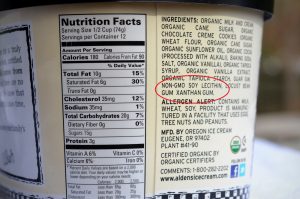
This can create or contribute to an imbalance in the gut’s natural state. This can lead to both immediate and long-term digestive tract issues.
What are the alternatives?
There are some ice creams out there that claim to be “healthier” ice creams, but when you read their ingredient lists, they still contain some of these harmful additives that have been discussed.
Always look for certified organic, naturally (truly naturally) flavored ice creams with ingredients like vanilla bean, cocoa, cinnamon, etc. with whole foods as the only ingredients. These may be a challenge to find, but they are out there!
Some brands to look for include Three Twins Organic Ice Cream, Julie’s Organic Ice Cream, local and grass-fed ice creams from your local farmer’s market, or homemade ice creams (homemade banana ice cream is a great, super easy one to make—simply freeze some bananas and then puree with your favorite spices!).
As always, read the ingredient list!! It is worth the extra effort to find or make high-quality foods you can indulge in once in a while without compromising your body’s health!
These ingredients in ice cream usually damage your gut. If you have a weak digestive system, and suffering from digestive issues, go to the next page and learn more about the 3 tips to reverse these digestive-related issues –
About the Author:
Emma Deangela is the best selling author of The Alkaline Diet Program and 80/20 Fat Loss. She has helped over tens of thousands of men and women to lose weight and transform their health with sound nutrition advice. Learn how you can lose weight fast – How to lose weight by adding these alkaline foods.
What’s your favorite brand of ice cream? Would you still eat ice cream after reading this?
Please share with your friends this cancer article using any of the social media and email buttons on the left of our website.


Leave a Reply